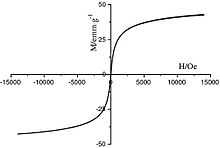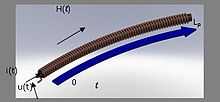Néel effect
The Néel effect appears when a superparamagnetic material placed within a conducting coil is subjected to varying frequencies of magnetic fields. The non-linearity of the superparamagnetic material acts like a frequency mixer. The voltage is measured at the coil terminals, then comprises several frequential components, not only at initial frequencies, but also at some frequencies of certain linear combinations. Therefore, the frequency shift of the field to be measured allows for the detection of a DC field using a standard coil.

History
In 1949, French physicist Louis Néel (1904-2000) discovered that when finely divided, ferromagnetic nanoparticles lose their hysteresis below a certain size.[1][2] This phenomenon is called superparamagnetism. The magnetization of these materials is subject to the applied field − which is highly non-linear, as shown in the graph in Picture 1. This curve is well described by the Langevin function, but for weak fields it can be simply written as:
 ,
,
where  is the susceptibility at zero field and
is the susceptibility at zero field and  is called the Néel coefficient. The Néel coefficient reflects the non-linearity of superparamagnetic materials at low fields.
is called the Néel coefficient. The Néel coefficient reflects the non-linearity of superparamagnetic materials at low fields.
Theory

Is a coil of  turns with a surface
turns with a surface  through which a current excitation
through which a current excitation  and immersed in a magnetic field
and immersed in a magnetic field  collinear with the axis of the coil. A superparamagnetic material is deposited inside the coil.
collinear with the axis of the coil. A superparamagnetic material is deposited inside the coil.
The electromotive force to the terminals of a winding of the coil,  , is given by the well-known formula:
, is given by the well-known formula:

where  is the magnetic induction itself given by the equation:
is the magnetic induction itself given by the equation:

In the absence of magnetic material
 and
and  . Differentiating this expression, it is obvious that the frequency of the voltage is the same as the excitation current
. Differentiating this expression, it is obvious that the frequency of the voltage is the same as the excitation current  and / or magnetic field
and / or magnetic field  .
.
In the presence of superparamagnetic material
Neglecting the higher terms of the Taylor expansion, we obtain for B:

New derivation of the first term of the equation  provides frequency voltage components of the stream of excitement
provides frequency voltage components of the stream of excitement  and/or of the magnetic field
and/or of the magnetic field  .
On the other hand, the development of the second term
.
On the other hand, the development of the second term  multiplies the different frequency components which intermodule frequencies starting components and generates their linear combinations.
multiplies the different frequency components which intermodule frequencies starting components and generates their linear combinations.
'The non-linearity of the superparamagnetic material acts as a frequency mixer.'
Calling  the total magnetic field within the coil located at the abscissa, by integrating the above induction coil along the abscissa between 0 and
the total magnetic field within the coil located at the abscissa, by integrating the above induction coil along the abscissa between 0 and  , and differentiating with respect to
, and differentiating with respect to  , we get:
, we get:
![u(t) = L \frac{dI(t)}{dt} + F_{Rog} \frac{d}{dt} \left[\int_0^{H} Lp(l) dl \right] + F_{Neel} \left[\int_0^{H} Lp(l) dl \right] I(t) \frac{dI(t)}{dt}](../I/m/34458698f642ca8fd93be565e410d323.png)
We can find the conventional terms of self-inductance and Rogowski effect in both the original frequencies. The third term is due to the Néel effect. It reports the intermodulation between the excitation current and the external field. When the excitation current is sinusoidal, the effect is Néel characterized by the appearance of a harmonic 2, carrying the information flow field:
![u(t)=LI_{ex}w_{ex}\cos(w_{ex}t) + F_{Rog}\frac{d}{dt}\left[\int_0^{Lp}H(l)dl\right]+F_{Neel}\left[\int_0^{Lp}H(l)dl\right]\frac{I_{ex}^2}{2}w_{ex}\sin(2w_{ex}t)](../I/m/6139a6c733c72d78017083524ece89f7.png)
with 

Applications
The Néel effect current sensor

An important application of the Néel effect is the measure of magnetic field radiated by a conductor with a current.[3] This is the principle of Néel effect current sensors,[4] which have been developed and patented by the company Neelogy. The interest of Néel effect is particularly to allow accurate measurement of currents or very low-frequency-type sensor with a current transformer without contact.
The transducer of a Néel effect current sensor consists of a coil with the core is a filled composite of superparamagnetic nanoparticles. The coil is traversed by a current excitation  . In presence of an external magnetic field to be measured
. In presence of an external magnetic field to be measured  the transducer transposes by Néel effect the information to be measured, H (f), around a carrier frequency, the harmonic of order 2 excitation current 2
the transducer transposes by Néel effect the information to be measured, H (f), around a carrier frequency, the harmonic of order 2 excitation current 2 , which is far easier.
The electromotive force generated by the coil is proportional to the magnetic field to measure
, which is far easier.
The electromotive force generated by the coil is proportional to the magnetic field to measure  and to the square of the excitation current:
and to the square of the excitation current:

To improve the performance of the measurement (linearity, temperature sensitivity, sensitivity to vibration, etc.), the sensor also includes a second permanent winding-reaction against it to cancel the second harmonic. The relationship between the current reaction against and the primary current is then purely proportional to the number of aliens against reaction ( ).
).
References
- ↑ Proceedings weekly meetings of the Academy of Sciences, 1949-1901 (T228) -1949/06, pp. 664-666.
- ↑ Louis Néel, "Theory of ferromagnetic magnetic drag grained applications with the terracotta", in Annals of Geophysics V, fasc. 2, February 1949, pp. 99-136.
- ↑ Magnetic field and current control method and magnetic core for these sensors / publicationDetails / library? CC = EN & NR = 2891917 "Patent FR 2891917."
- ↑ method for measuring current by means of a flow sensor of magnetic fields of a specific shape, and the resulting system has from such a process, "Patent FR 2971852"]